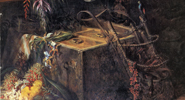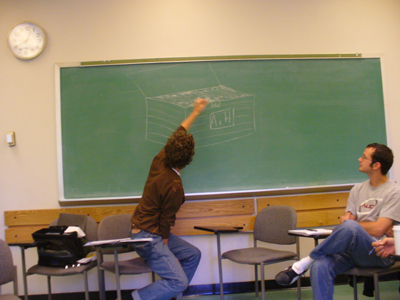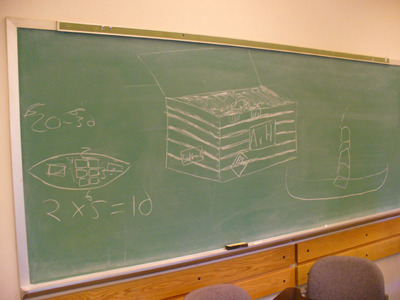 |
Alexander von Humboldt in und nach seiner Zeit - und in unsrer Zeit: das "Humboldt-Projekt" der PSU |  |
last modified: |
External links valid as of 14 October 2008
Organizing principles: 1) AvH as a major example of the interaction of the Enlightenment and Romanticism with the New World's landscape, creatures, and peoples - and in his lifetime possibility the most famous German, worldwide and to the greatest range of people; 2) AvH as a notable figure in the development of the concept of sustainability; 3) the development of the PSU "Humboldt Project" as a reflection of 1 & 2 and of the University's Campus-Wide Learning Outcomes goals
I. 1769-1859; Prussia, but lots of Paris; member of the nobility; education and early professional work in geology & mining; major expedition to the Americas; thereafter a lifetime of scientific investigation and writing, and of political activism. More: Wikipedia "AvH" • Helferich's "Cosmos" book • Sach's "Humboldt Current" book
II. The intellectual & scientific background: Hamann & Herder (modern concepts of culture, folklore, comparative linguistics); Kant (critique of reason; ethics); and the scientific background: Linnaeus and biological classification, the French Enlightenment scientists, the geologists, the major voyages of Cook and Bougainville (Johann & Georg Forster with Cook - also a connection to European radical thought). And the unavoidable Goethe, Schiller, etc.
III. The expedition and travels: 1799-1804 Latin America - essentially an individual effort that produced a prodigious amount of data which AvH processed during the subsequent 55 years of his life. The chief work: "Kosmos" (5 volumes, 1845; facsimile in PSU library, along with other early texts). The 1799-1804 expedition included side-trips through Mexico and to the USA. Professional writings in French, German, Spanish, English. The key expression: "Everything is interrelated" - in the environmental / ecological sense, of course, but also in the humanitarian and even (brother Wilhelm von H.) linguistic senses. The direct, often visceral experience: the bugs, the electric eels, the rivers, the Andes, the dysentery.
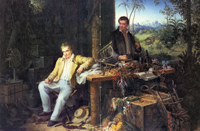 |
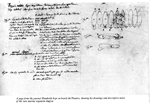 |
 |
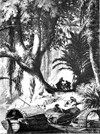 |
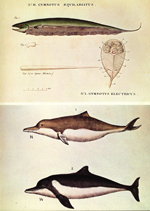 |
 |
 |
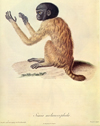 |
 |
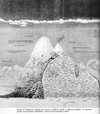 |
 |
IV. A lifetime of humanitarian and human rights advocacy: early experience of French Revolution; reaction to slavery in the New World (criticism of Jefferson and, later, of the South in the lead-up to the Civil War); continued advocacy of human rights and social progressivism (1848 revolution). And then, until recently, virtually forgotten, except for some little places and people. Why AvH became almost totally forgotten after his death - or did he?
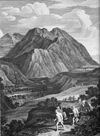 |
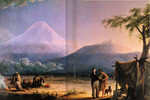 |
 |
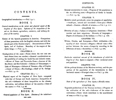 |
 |
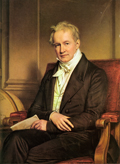 |
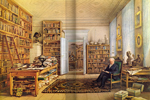 |
 |
 |
V. Humboldt-named geophysical features and life-forms
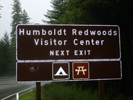 |
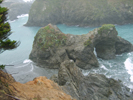 |
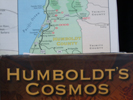 |
| link to "named for Humboldt" | link to "cyanea humboldtiana" |
I. Romanticism and the New World: Yes, the tremendous emphasis on the individual and on subjectivity (Goethe's heroic figures: "Heilig, glühend Herz", "Gefühl ist alles", and the suicidal Werther). But more relevant here: Sense of landscape as both something to enter into and as something beautifully or terrifyingly sublime. See Furtwangler book on Lewis & Clark ("sublime"; the landscape going through them [its plant and animal foods] as they went through the landscape). Visual arts: painters like Albert Bierstadt (View of Mount Hood)
II. Aaron Sachs (book excerpt) drives it all home: AvH as an originator of the concept of sustainable environmentalism: "To the pragmatic Humboldt, who also had an unconditional love for the natural world as a whole, the point was to achieve sustainable use - 'a more enlightened employment,' as he explained in Cosmos, 'of the products and forces of nature'" (p. 84). Thereafter Sachs covers the thought, activities, writings, and even pictures of American explorers, naturalists and environmentalist in inimitable breadth and depth. A brief exploration of the interrelation of European Romanticism with American environmentalism can be found in an article in Oregon Humanities Journal by a PSU history professor.
A special issue: the current state and future direction of Germanistik and the teaching of Germam in America; need to find new learners and new paths to them, and to expand our subject area (which using the HP to attract students to languages)
I. Mission Statement: The "Humboldt Project" supports better learning and teaching, for all students and in all subject areas. It does so by developing pedagogically sound and learner-centered curriculum enrichment resources based on the life and work of Alexander von Humboldt, the great German scientist, scholar, pioneer of ecology and environmentalism, explorer of the Western Hemisphere, and early advocate of human rights. The Project's activities are directed primarily but not exclusively at schools in North America named for Humboldt. The Project seeks to network them with each other, and to like-named schools in Latin America and Germany. (More)
 |
 |
 |
|
Humboldt's sketch of the Rio Meta geography - the start for a module about math & geography |
An example of isotherm lines, which Humboldt first developed - subject areas: social studies, environmental studies |
A shell species named for Humboldt - subject areas: biology, environmental studies |
| link to list of Humboldt-named schools | link to curricular resources | Oregonian article about PDX Humboldt Elementary School |
II. Its multiple roots: a) A winter-quarter 2006 course ("Reason & Revolution") whose immediate inspiration was Helferich's Cosmos and a book about Jefferson in Paris, but whose deeper inspiration was b) the need to transform an endangered subject area. But there's more: c) many years of work in PPS and Oregon language curriculum standards, with frequent crossover into those of other other subject areas (math, science, social sciences, language arts, fine arts / music); d) 2006 work with CEPR on the "middle-50%" project (improving chances for college success; learning modules "Disasters" and "Revolutions in Science"); e) much earlier participation (1994) in the first FRINQ courses; f) frequent work with assessment, including (currently) PSU Institutional Assessment Council, which is formulating approaches to instituting and assessment Campus-Wide Learning Outcomes, with special attention to sustainability, internationalization, diversity, and communication; f) a much earlier interest in technology, science, and the history of both, including fascination with an article about how slaves in SE US were able to mitigate their circumstances by applying their superior knowledge of rice cultivation).
I guess that in my own development here I've recapitulated the development of curriculum, outcomes and assessment at PSU - in my thought and in courses.
III. Briefly: the schools and their learners; the "Box"; the modules
|
|
|
|
|
One of Humboldt's expedition boxes, the source of the idea for > |
replicas of the boxes as containers for kits of learning modules |
The boxes would contain teacher manuals, learning modules, props (scientific instruments, even an AvH costume and, for younger learners, hand puppet) |
| Leonard Allen's NYC 2007 Conference | Doing math about indigenous peoples | Nature Conservancy and NYC schools |
IV. Taking it from here: content-based instruction training for teache
